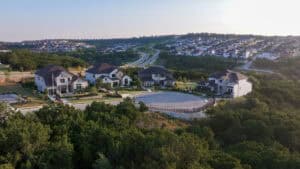Does your lazy days of summer backyard bliss include sitting poolside in your every own backyard? For most of us the answer to that question is a resounding and unequivocal YES. There is something about having your own backyard pool. The convenience of being able to take a quick swim anytime you want is well-worth all the things that come with it. Or, is it? Which is what we’re about to discuss here. Putting an in-ground pool in your backyard takes some serious thinking, decisions, research, and depending on your choice of materials, some serious cash.
Popularity of in-ground pools continue to grow. According to a 2019 report from the Association of Pool & Spa Professionals there are 10.4 million residential and 309,000 public swimming pools in the U.S. However, throughout the years they have changed quite a bit. Today, they are elaborate designs custom-made to accentuate your home and backyard landscape. These built-in watery palaces are just that—backyard castles waiting for you to take command. Something, most of us can handle quite seamlessly.
So, when and how do you begin? Since it’s already spring, it may be a little late to plan for this year. However, if you start now you can get a head start for next year’s swimming season. To help you make a big splash, we did some research and came up with a check list. Here’s a quick preliminary guide to get you started.
Envision your backyard space with a pool
When installing a pool it is imperative your backyard has adequate space. Once you determine it isn’t an issue you can begin. Choosing the right location is crucial. So, tour your space. Placing your pool in the sun is a great way to take advantage of a free energy source. Also, distance your pool away from trees. Having shade is great during scorching Texas summers, but fishing leaves out of a pool isn’t much fun. And, be mindful of the wind and both high and low-lying areas that may flood. Frequent winds can result in water loss and can be uncomfortably cold when climbing out of the water.
Choose the type of pool
There are three primary pool types—concrete, vinyl-lined and fiberglass. Each one is different but produces the same result.
- Concrete pools – The shell of a concrete pool is made from Gunite and can be formed into any shape or size. Truly custom-made they can fit any size yard. Most likely you’ll choose from an oval, rectangle, square, or kidney-shape. But, hey you could make it into any shape you want. Concrete pools are permanent, have long shelf lives, and can be updated and remodeled over time. And, they can be simply beautiful. But, there are disadvantages. Installing them can be a lengthy process. They also take more time to maintain, use more chemicals, have a rough interior surface, and cost more to install. Overtime, cracks can also occur.
- Vinyl-lined – A slightly different look and feel here. But, again, same result. Vinyl liner pools have a custom made sheet of vinyl between the water and the pool walls and floor. For the most part vinyl pools are rectangular. However, the shape, size, and depth can be customized for an additional expense. On the average, these pools can be installed in 4-8 weeks. Which means, it is possible to start construction in May and still have most of the summer to enjoy it. Expect to outlay anywhere from $20,000 to $55,000 for the initial cost. You’ll also have to replace the liner every 5-10 years with the average cost to replace it between $4,000 – $4,500 which includes labor and materials.
- Fiberglass – These types of pools are made out of 100% fiberglass and are pre-made and formed in factories. Essentially, they are giant shells installed as one enormous piece lowered into the ground by crane. Consequently, there is little room for customization. However, contractors selling fiberglass pools will have them in a variety of sizes, depths, and colors. Cost-wise they can range from $20,000 to $45,000. However, just like with the other two types there are other variables to consider and cost can vary. Fiberglass pools take 2-6 weeks to install. But, they can take less time which is a major advantage. Other advantages include durability, a nonporous surface, resistance to staining, and low maintenance. On the flip side over time fiberglass tends to dull and is more costly than a vinyl liner pool. Learn more about the pros and cons of fiberglass here.
Select a contractor
After you select the pool type you can choose a contractor. So, do your research. Check references. If it’s possible visit someone in your neighborhood that used the contractor you are considering. Also, read reviews. People are usually very honest about their experience with contractors. And, be sure to ask about their warranty and customer service policies. Make sure you are comfortable with their work and products. Not only will the contractor install your pool they will also help you site the ideal location and orientation. And, guide you through the design process too.
Apply for a building permit
Like any other home improvement project in-ground pools are prone to zoning and building regulations. So, before you begin you must apply for a permit. You will receive a permit when your plan is reviewed and approved. Code requirements will depend on the town in which you live. However, most likely you will need to consider regulations such as setbacks from the pool to property lines, septic tanks, wells, sewer lines, flood areas, and more. Fences, gate hardware, and pool barriers are also subject to code regulations.
Seek HOA approval
Before you begin your pool project you will have to submit your approved building permit to your Homeowner’s Association. Most HOA’s have certain aesthetic requirements that you will need to adhere to written in their bylaws. Save yourself some time. Read them first then take into consideration the regulations as you proceed. After you submit your approved permit your HOA will either give their approval or provide feedback. Note, that you may also have to submit any additional landscaping plans or design elements associated with the project.
Be aware of additional expenses
When creating your budget it’s important you don’t discount additional items that will undoubtedly add to the project’s bottom line. Fences, landscaping, filters and equipment, supplies, and lifetime maintenance are just a few. But, there’s also other things to consider such as outdoor lighting, patio furniture, pool toys, exterior storage areas, decks, and additional safety devices to name a few.
Visit Travisso in Leander today
Travisso offers state-of-the-art floor plans from award-winning premier builders. Choose homes ranging in size from 1,900 to over 5,000 square feet with prices starting in the 300s. And, there’s much more including resort style amenities, over 10 miles of proposed walking and biking trails, and a future 58 acre on-site regional park perfect for your active lifestyle. Visit us in Leander today and explore our new model homes and neighborhoods. For additional information call us at 512-243-8583.


